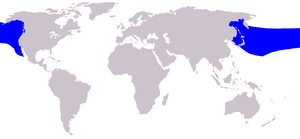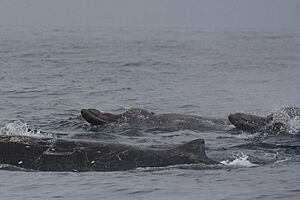Baird's beaked whale facts for kids
Quick facts for kids Baird's beaked whale |
|
|---|---|
 |
|
| Baird's beaked whale (Berardius bairdii) | |
 |
|
| Size compared to an average human | |
| Conservation status | |
| Scientific classification | |
| Genus: |
Berardius
|
| Species: |
bairdii
|
 |
|
| Baird's beaked whale range | |
Baird's beaked whale, also known as the northern giant bottlenose whale, is a type of whale from the Berardius family. It has many other names, like the North Pacific bottlenose whale. For a long time, scientists wondered if Baird's beaked whale and Arnoux's beaked whale were the same species. But now, they are considered different species because of their genes and where they live. This whale is the second largest living species of toothed whale, right after the sperm whale.
Discovering Baird's Beaked Whale
Baird's beaked whales were first officially described in 1883. An American scientist named Leonhard Stejneger did this. He studied a skull from a whale that had washed ashore on Bering Island. The species was named after Spencer Fullerton Baird, who was a important person at the Smithsonian at that time.
What Does Baird's Beaked Whale Look Like?
These whales are very long! Males can grow to about 39 feet (11.9 meters). Females are even bigger, reaching up to 42 feet (12.8 meters) long.
They have a long snout, which is called a beak. Unlike many animals, they have very few teeth. They only have one or two sets of teeth in their lower jaw. These teeth are sometimes called "battle teeth." This is because the whales use them when they fight with each other. You can often see scars on these whales from these fights.
Baird's beaked whales can live for a very long time. Some have been known to live for up to 84 years!
Where Do Baird's Beaked Whales Live?
These whales mostly live in the North Pacific Ocean. They are deep-water whales, meaning they like to swim in very deep parts of the ocean. They often search for food at depths between 3,300 and 9,800 feet (1,000 and 3,000 meters).
You can find them in the northwestern Pacific near places like Hokkaido, Japan, Sakhalin, and Kamchatka. They also live in the Sea of Okhotsk, the Bering Sea, and around the Aleutian Islands. Further east and south, they have been seen off southern Alaska. They also swim down the U.S. West Coast all the way to San Diego and northern Baja California.



